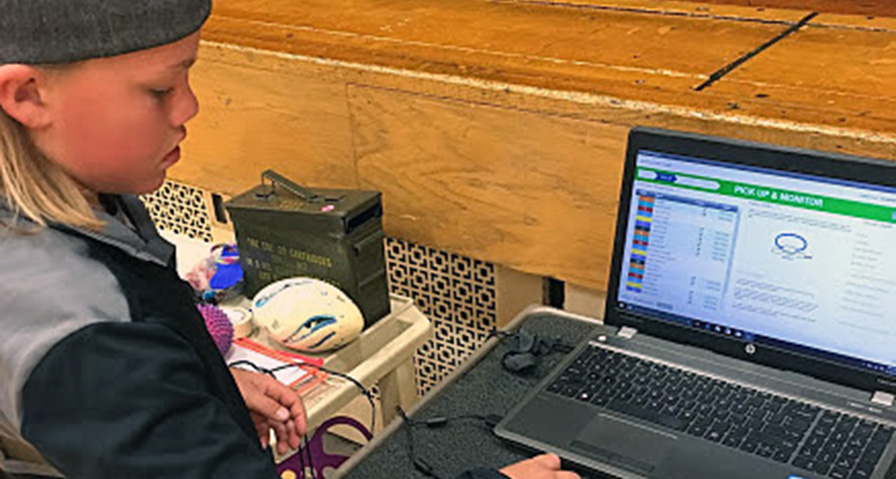Teachers Use Fitness Data From Heart Rate Monitors To Educate Students on Management of All Fitness Levels
Physical education teachers use heart rate technology to show students how hard they need to exercise in class to positively impact their fitness levels.
A 24-year teaching veteran, Rock River (Wisc.) Intermediate School PE teacher Jackie Clark has always made it a priority to include the latest technology in her classes. She started with pedometers 15 years ago but knew they couldn’t give her – and especially her students – a full picture of how effective a workout was. While her students grasped the importance of activity, Clark wanted to give them a greater understanding of moving at an elevated heart rate.
“I saw the motivation of my students increase tremendously because now it is not just about showing me their score, but [that data] gets saved now in a database for me to justify how active my kids are as well as reflect on my lesson to make sure I gave my kids enough opportunities to move,” she said.
In her tenure, she’s taught students of all fitness levels:
- inactive students with unhealthy habits;
- active students who wouldn’t engage during physical education class; and
- fit students who appear active without putting forth maximum effort.
Clark saw new PE heart rate monitors as a tool by which she could educate students of all fitness levels on the impact of time spent exercising in target heart rate training zones.
“My kids were ready for that next challenge,” Clark said. “My next vision was to bring heart rate technology to my program. Teaching heart rate has always been difficult with elementary students. Yeah, they know how to find their pulse, how to count their pulse, and know that exercise increases their heart rate, but without having on a heart rate monitor they don’t really know exactly how long they were in their target heart rate zone.”
At the beginning of the current school year, Clark added the IHT Zone wrist heart rate monitors to her PE curriculum. She’d been saving money raised through grants and other fundraisers for more than three years and said the results she’s seen with her students made the wait worth it.
“My students have never been more motivated to ‘get in their zone’ before,” Clark said.
Personalizing Class with PE Heart Rate Monitors
Clark started the year by teaching students the basics of their heart rate and their target heart rate zones. With the colors displayed on the face of the Zone, students easily grasped the concepts and began to evaluate their own progress, and the teacher stressed that each student’s heart rate data would be specific to their own fitness level.
After the first session, one of Clark’s cross country runners couldn’t believe what his heart rate monitor showed him about his time in the target heart rate zone.
“The biggest ah-ha moment was when one of my cross country runners downloaded their heart rate monitor one of those first days and was in their zone for only a couple minutes while a fellow student who was not that fit, was in their target heart rate zone 27 minutes and surpassed their goal of 21 minutes,” she said. “The cross country student was mad and didn’t think the monitors worked.”
Undeterred by her student’s frustration, Clark immediately took advantage of the teachable moment with dramatic results.
“We had a great conversation about how his heart is much stronger than his fellow student who wasn’t as fit and that fitness is not one size fits all and I challenged him to get in his zone the next class period,” she said. “That was all the motivation he needed to prove to himself he could get in that zone.”
Three PE sessions later, the cross country runner met his goal and hasn’t stopped meeting it since, demonstrating a new understanding about the type of workout he needs to help his already high fitness level.
“It was his ah-ha moment,” she said, “when he got it and finally felt what being in his zone felt like and looked like for him.”
Creating PE Success for Students of All Fitness Levels

While Clark’s breakthrough with her cross country student is significant, heart rate monitors help teachers connect with students who struggle with their fitness and often don’t enjoy being in a physical education class. Connections formed with those students prove monumental to teachers.
“Those are the kids you worry about,” said Portage Central Middle School P.E. teacher John Dunlop. “It’s the kids who this doesn’t come as easy for who need to experience success and get some feedback as to what they’re really doing.”
Dunlop’s breakthrough moment came with a student he said simply didn’t enjoy school, much less P.E.
“He hates PE, he doesn’t really like school and he struggles a little academically,” the teacher said. “When we started using the heart-rate monitors, I saw a complete change in his attitude.”
With a connection forged over the PE technology, the student participated fully in class. When he looked at his IHT Spirit System heart rate report following the workout, he saw that he met his goal for minutes spent exercising in the target heart rate zone.
“He said, ‘hey, I did pretty good today,’” Dunlop recalled. “I don’t know if that kid has ever experienced success in PE until this year.”
PE Technology Leads to More Impactful Assessment
The data that the IHT Zone makes available to students, teachers and parents helps each stakeholder see exactly what is taking place with each student. Post-session reports show which students are working hard and which can be pushed to work harder. The PE technology enables teachers to effectively see each student work out even if they can’t watch them all constantly during class.
“Many times some P.E. teachers assume that if a kid is not running they are not working hard,” Clark said. “In reality, an unfit child can be walking and still in their target heart rate zone.”
Through her new PE technology, Clark receives information about each class’ performance. She can see an overview of how many students met the day’s goal for minutes spent exercising in the target heart rate zone and how many didn’t. She can also view each student’s individual report to see what reinforcement or encouragement she can give.
“I now have concrete data where my students can really personalize their own fitness level and set realistic goals based on their data,” Clark said.
By using PE technology to empower students to understand how to set realistic goals for their workouts, teachers are laying the foundation for that student to lead a healthy, active life. It starts by enabling all students to find their success and grow from there.
“And if they’re proud, and making progress, then they are much more likely to want to continue,” said Draper Middle School PE teacher Doug Hallberg, a SHAPE America PE Teacher of the Year in 2017. “That, I think, is the ultimate goal: get a kid to want to take care of their own fitness level.”
Seeking IHT Spirit System information?


